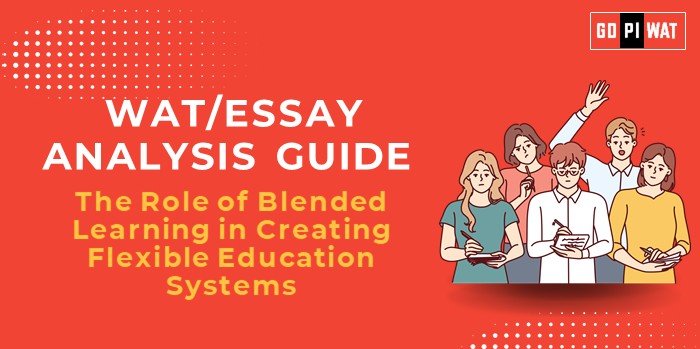📋 Written Ability Test (WAT)/Essay Analysis Guide: The Role of Blended Learning in Creating Flexible Education Systems
🌐 Understanding the Topic’s Importance
Blended learning is crucial for creating resilient education systems that adapt to disruptions like pandemics while promoting equitable access and enhancing learning outcomes.
📝 Effective Planning and Writing
- Time Allocation:
- Planning: 5 minutes
- Writing: 20 minutes
- Review: 5 minutes
- Preparation Tips: Identify relevant statistics, consider stakeholders, and structure arguments logically.
💡 Introduction Techniques for Essays
- Contrast Approach: “While digital tools revolutionize education globally, a lack of access remains a pressing issue in many regions.”
- Solution-Based Approach: “Blended learning offers a pathway to adaptable and inclusive education, merging traditional and digital frameworks.”
📊 Structuring the Essay Body
- Achievements: Increased access, better engagement, personalized learning.
- Challenges: Infrastructure gaps, digital literacy issues, cost barriers.
- Future Outlook: AI integration, global partnerships, and improved policies.
📜 Concluding Effectively
- Balanced Approach: “Blended learning is a transformative force, but addressing access and infrastructure challenges is vital.”
- Future-Focused Approach: “With robust support, blended learning can revolutionize education systems worldwide.”
📈 Analyzing Successes and Shortcomings
- Key Achievements: Improved outcomes and access.
- Ongoing Challenges: Digital divide, resistance to change.
- Global Context: Finland as a model, India’s growing adoption.
✅ Recommendations for Sustainable Progress
- Enhance public-private partnerships to fund infrastructure.
- Implement targeted digital literacy programs.
- Strengthen cybersecurity measures for educational platforms.
✍️ Sample Short Essays
- Balanced Perspective:
“Blended learning combines traditional methods with digital innovation, enhancing engagement and outcomes. However, unequal access and infrastructure limitations challenge its inclusivity. Addressing these issues is essential for its success.”
- Solution-Oriented:
“By integrating AI and expanding digital access, blended learning can transform global education systems, fostering equitable opportunities for all.”
- Global Comparison:
“Countries like Finland demonstrate the potential of blended learning, while developing nations like India illustrate its challenges and opportunities.”


